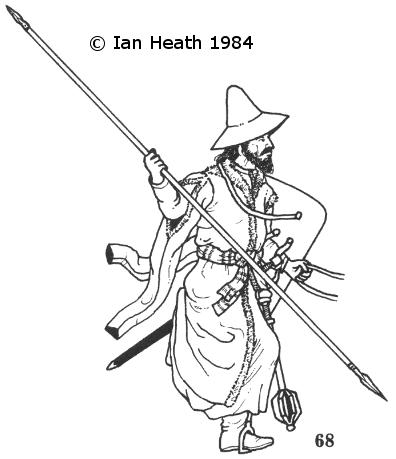
Create an Amazon Wedding Registry
ALBANIAN CAVALRYMAN, 15th CENTURY
An extract from Armies of the Middle Ages, Volume 2by Ian Heath



68. ALBANIAN CAVALRYMAN, 15th CENTURY
The Albanians were mostly light cavalry armed with sword or sabre ('which is a terrible weapon', says Philippe de Commynes), a mace hung at the saddle-bow, and a lance or zagaie, the latter being a javelin 10-12 feet in length with a blade at each end, wielded overarm. Others carried a crossbow or a bow instead. In addition some were foot-soldiers, mostly archers but including some crossbowmen and javelinmen plus peasant levies; by the 1440s some Albanian infantry were even armed with handguns. The costume of the figure depicted here is typical, particularly the characteristic Albanian hat and the hanging sleeves. The latter appear in Byzantine and Albanian pictures as early as the first half of the 14th century, and it was probably from Albania or elsewhere in the Balkans that the Ottomans and Italians copied this fashion, the latter introducing it to Western Europe by c. 1430. Such sleeves were actually being described as 'Albanian' by the 16th century. Doubtless they were tied behind the back or stuffed through a belt in battle, as described under 10. Popular clothing colours were scarlet (for the nobility), red, green and blue.
Albanians were to be found fighting for the Venetians by the beginning of the 15th century at the latest. However, after the conquest of Albania by the Ottoman Turks in the 1470s they (and, later, Greeks and Croats) began to appear in Venetian employ in noticeably larger numbers under the name of 'stradiots', this deriving from the Byzantine Greek word stratiotes, the term used for a pronoia-holding soldier. (William Miller, however, proposed an alternative origin for the word, suggesting in his Essays on the Latin Orient that it derived from Italian strada, meaning a road, in the sense that they were wanderers always on the road.) Commynes described stradiots in Venetian service at the Battle of Fornovo in 1495 thus: 'They are horse and foot, and dressed like Turks except that they wear no turbans on their heads. They are hardy people, and lie abroad all the year round with their horses; they were all Greeks, from the places which the Venetians possess in those parts, some of them from Naples and Romania and the Morea, others from Albania and Durazzo. Their horses are all Turkish, and very good. The Venetians employ them often in their wars, and put great confidence in them, their number was near 1,500.' He also tells us that their pay took the form of a ducat per enemy head taken, the same pay as was given in 1470 to Serbian hussars in Matthias Corvinus' employ, to whom they were in most respects very similar. Armour where worn comprised no more than a mail corselet (worn under the coat), plus a shield.
Scanderbeg's flag is described by the chronicler Barletius as red charged with a black, double-headed eagle.